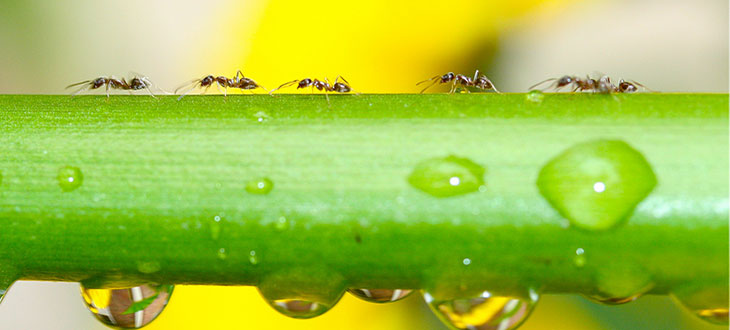How Ants Go Marching And Never Cause Traffic Jams

(Inside Science) -- The old children's song about marching ants is a good explanation for why traffic engineers love them.
Ants -- most are teeny creatures with brains smaller than pinheads -- engineer traffic better than humans. Ants never run into stop-and-go-traffic or gridlock on the trail. In fact, the more ants of one species there are on the road, the faster they go, according to new research.
Researchers from two German universities, the Universities of Potsdam and the Martin Luther University of Halle-Wittenberg, found a nest of black meadow ants (Formica pratensis) in the woods of Saxony. The nest had four trunk trails leading to foraging areas, some of them 60 feet long. They chose a small area and set up a camera that took time-lapse photography, and recorded the ants coming through the zone.
Trunk trails are the main highways in and out of the nest, said Christiane Hoenicke, a doctoral student at Potsdam and co-author of the paper in Science of Nature (or Naturwissenschaften).
The ants set it up as a three-lane highway, a kind of "lane segregation," Hoenicke said.
When traffic was slow, the ants generally walked down the middle of the trail. When traffic picked up, the ants spread out from the center.
"At medium density, inbound ants still concentrated on the central lanes, but outbound ants were recorded at all lanes and showed no lane preference," the researchers wrote. Ants leaving the nest went to the right on the path; ants bringing back food and returning to the nest went to the left. The center was where the two streams met, she explained.
Oddly, the heavier the traffic, the faster the ants marched. Unlike humans on, say, the Santa Monica Freeway, their velocity increased with the number of traveling ants and the trail widened as the ants spread out.
If an ant came across a blockage in the road, for instance a leaf or small stone, the ant would pick it up and move it off the road and then continue walking, making sure traffic was not interrupted.
No matter how fast they went, there was never a traffic jam. The number of ants could reach hundreds of thousands but traffic on the trunk trail -- unlike a car-clogged highway -- kept moving.
Even collisions did not slow them down. Of course, Hoenicke said, there were accidents, mostly head-on collisions. While humans would stop and exchange insurance information or call an ambulance, blocking traffic and shutting down lanes, the ants use the occasion to exchange traffic information and news of the trail, and then quickly move on, with the incoming ants going to the left of the outgoing insects.
Incoming ants moved faster because they have two valuable resources: they are usually carrying food for the nest and have information about the foraging area so they move faster than those exiting the nest.
If the ant ahead is going too slow, the ants behind just pass, usually on the right. Hoenicke said she doesn't know whether there is much lane switching as there is on human highways -- often the cause of accidents.
Densities were distributed evenly in all lanes so the traffic was even in both directions.
The researchers tweaked the situation by providing additional food in the foraging areas to build traffic, and they still could not create traffic jams. The ants adjusted. Velocity and density were directly correlated even when both doubled.
Other species of ants have different traffic engineering, Hoenicke said, and their traffic-coping mechanism might differ from the ants in the study.
The ants are both engineering their highways and adjusting their traffic on the road. They establish routes from their nest to their foraging area, then straighten out the road, cut shortcuts and maintain it, just as human engineers do. While on the road, they adjust where they go and how fast they go, just as human drivers do.
Human traffic engineers can manipulate lanes as the ants do to speed traffic. During rush hour, traffic officials open more lanes in one direction and fewer in the other, as they do in cities like Berlin and Washington, D.C.
Does that mean ants have a better traffic algorithm than human engineers or drivers?
It may not be that ants are smarter than we are, said Berthold K.P. Horn, professor of computer science and artificial intelligence at the Massachusetts Institute of Technology. They just may have a better sense of the traffic.
"Ant vision is not that great so I suspect that most of the information comes from tactile senses (antennas, legs). This means they are actually aware of not only the ant in front, but the ant behind as well," he wrote in an email to Inside Science. "That reduces the instability found in automobile highways, where drivers only know about the car in front."
Still, Hoenicke said, human highways are not self-organized like the tiny-brained ants.
Horn, who researches the vagaries of human traffic, agreed. He pointed out that when things got really rough, some of the ants would leave the trail and walk on the grass.
"That’s as if we were able to add lanes when the traffic density goes up. Which would be nice!"

